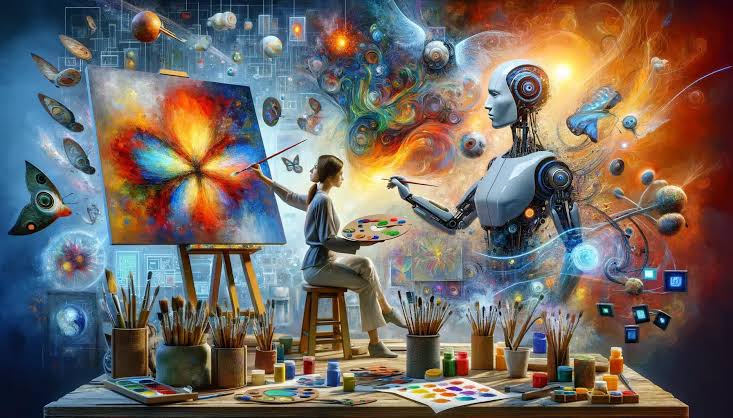AI Art and Emotions: Exploring the Emotional Resonance
Exploring the intersection of technology and creativity, this article delves into how AI-generated art can evoke emotional responses in humans, challenging traditional notions of artistic expression and emotional resonance.
AI Artwork | September 10, 2024
Exploring the intersection of technology and creativity, this article delves into how AI-generated art can evoke emotional responses in humans, challenging traditional notions of artistic expression and emotional resonance.
AI art, a growing field where technology meets creativity, is gaining popularity among both art lovers and tech enthusiasts. As AI advances its use, in the world of art raises thought provoking questions about what creativity truly means the role of human emotions in artistic expression and whether machines can genuinely elicit feelings through their creations. Central to this exploration is the concept of resonance the ability of a piece of artwork to stir an emotional reaction from its viewers. To understand AI arts potential for resonance it's important to delve into how AI generated art works the range of emotions it can evoke and the broader implications for the future of art and the interplay, between humans and technology.
Creating art with AI usually involves using learning methods like generative adversarial networks (GANs). These methods enable machines to generate images, music and even poetry. By training on large sets of existing artworks these algorithms learn to recognize styles and techniques that they can later mimic or even innovate upon. Essentially the machine acts as a student of human creativity soaking up the intricacies of brush strokes, color choices and composition methods to produce something original. The outcome can be stunningly beautiful, odd or emotionally resonant. Yet the question arises whether the emotions expressed are truly felt by the machine or simply interpreted by the observer who projects their own emotions onto the artwork.
When talking about the impact of AI art it's important to understand what emotions are. Emotions are feelings that come from a mix of memories, cultural influences and personal psychological states. Throughout history art has been a way to express and evoke emotions allowing artists to share their deepest thoughts and feelings through visuals, sounds or written words. On the hand AI doesn't have the awareness or experiences to create emotions. It uses data patterns to imitate showing emotions. For example an AI can create a painting using colors and shapes that resemble how a human artist might express sadness. However the AI doesn't actually feel sadness. It's just a response from the viewer based on the visual cues that the AI has been programmed to mimic.
The difference, between how emotions are generated and how they are perceived is crucial. Presently AI generated art lacks the awareness or personal experiences needed to infuse its creations with intentional emotional depth. However this doesn't undermine the potential influence of AI art on audiences. Similar to how a stunning landscape or a beautifully crafted musical composition can evoke feelings of tranquility or happiness AI art has the ability to stir emotions based on its qualities even if those qualities are determined by algorithms. This interplay between art and human emotions opens up avenues, for exploring and understanding art in ways.
An interesting facet of AI art is its capacity to astonish and disrupt our established perceptions of creativity and sentiment. Unlike artists AI functions through algorithms and data freeing it from the constraints that human creators face. This flexibility empowers AI to explore styles and ideas that may be unconventional or beyond the realm of human imagination. Consequently AI generated artwork has the potential to expand our understanding of evoking emotions providing avenues to encounter feelings through surreal depictions that question the standards of emotional portrayal in art.
Furthermore AI generated artwork can act as a reflection of our feelings and prejudices. Since AI learns from the information provided to it the art it generates often mirrors the tastes trends and cultural backgrounds of the human artists and viewers who input the data. This reflective nature can offer glimpses into the emotional fabric of todays world and underscore how our emotions are molded by influences and technology. In this regard AI art is not a creation but rather an engaged player in the conversation surrounding the impact of emotions, on both art and life.
The discussion about the future of AI art and its impact on resonance is an ongoing one. With progress in AI technology there is a possibility that machines could learn to imitate expression in ways. This could lead to the creation of art that comes closer to capturing the emotional depth found in works. However it's crucial to acknowledge the limitations of AI in this realm. Regardless of how advanced the technology gets AI is unlikely to genuinely experience emotions, like humans do. Instead its role in the process may involve boosting human creativity by providing tools and perspectives that broaden our understanding of emotion and artistry.
To sum up, AI generated art offers an intriguing look into the blend of technology, creativity and emotions. Although AI doesn't possess the ability to feel emotions the artwork it creates can still stir deep reactions, in people. This raises questions about the relationship between art and feelings prompting us to explore how technology can shape and enrich our artistic endeavors. As we delve into the realms of AI in art we should approach advancements with a mix of curiosity and thoughtful consideration acknowledging the distinct roles that both humans and machines play, in the art world.
